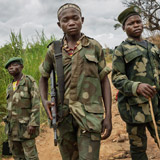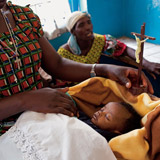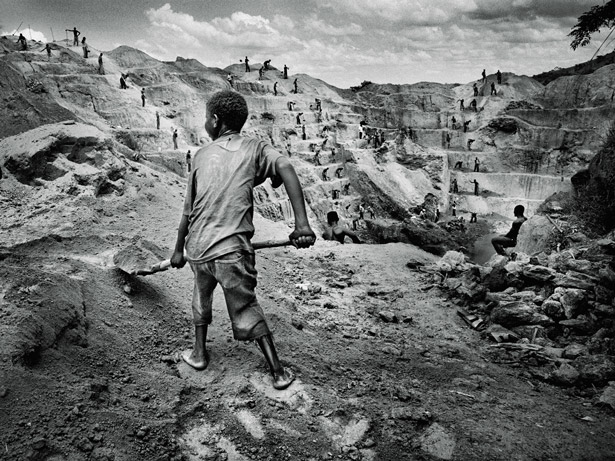The first child soldier pops out of the bush clutching an AK-47 assault rifle in one hand and a handful of fresh marijuana buds in the other. The kid, probably 14 or 15, has this big, goofy, mischievous grin on his face, like he’s just stolen something—which he probably has—and he’s wearing a ladies’ wig with fake braids dangling down to his shoulders. Within seconds his posse materializes from the thick, green leaves all around us, about ten other heavily armed youngsters dressed in ratty camouflage and filthy T-shirts, dropping down from the sides of the jungle and blocking the red dirt road in front of us. Our little Toyota truck is suddenly swarmed and immobilized by a four-and-a-half-foot-tall army.
This is on the road to Bavi, a rebel-controlled gold mine on the Democratic Republic of the Congo’s wild eastern edge. Congo is sub-Saharan Africa’s largest country and one of its richest on paper, with an embarrassment of diamonds, gold, cobalt, copper, tin, tantalum, you name it—trillions’ worth of natural resources. But because of never ending war, it is one of the poorest and most traumatized nations in the world. It doesn’t make any sense, until you understand that militia-controlled mines in eastern Congo have been feeding raw materials into the world’s biggest electronics and jewelry companies and at the same time feeding chaos. Turns out your laptop—or camera or gaming system or gold necklace—may have a smidgen of Congo’s pain somewhere in it.
The mine in the Bavi area is a perfect example. It’s controlled by a potbellied warlord called Cobra Matata, though “controlled” may be a strong word. There are no discernible front lines out here marking where government rule definitively ends and Cobra’s territory definitively begins, no opposing troops hunkered down in trenches or foxholes eyeballing each other through their scopes. Instead there are just messy, blurry degrees of influence, often very marginal influence, with a few Congolese government guys lounging under a mango tree in one place, and maybe two miles down the road a few of Cobra’s child soldiers smoking pot, and nothing in between but big, vacant, sparkling green wilderness.
“Sigara! Sigara!” the child soldiers yell, seeking cigarettes. Photographer Marcus Bleasdale and I quickly push fistfuls of Sportsmans, a local brand, out the window, and they are instantaneously gobbled up by feverish little hands. That seems to do the trick, along with a few thousand crumpled Congolese francs, worth less than five bucks, and then we’re on our way again, rumbling down an excruciatingly bumpy dirt road, past thatched-roof villages and banana trees. In the distance giant mountains nose the sky.
When we get to Bavi, we sit down with the village elders and talk gold. The world gold price has quadrupled over the past ten years, but there’s no sign of development or newfound prosperity out here. Bavi has the same broken-down feel of any other village in eastern Congo: a clump of round huts hunched by the road, a market where the shops are made of sticks, shopkeepers torpidly selling heaps of secondhand clothes, and glassy-eyed men reeking of home brew stumbling down the dirt footpaths. There’s no electricity or running water, and the elders say they need medicine and books for the school. The kids are barefoot, their bellies pushed out like balloons from malnutrition or worms or both.
“We’re broke,” says Juma Mafu, one of the elders. “We’ve got a lot of gold but no machines to get it out. Our diggers use their hands. No big companies are ever going to come here unless we have peace.” Which they clearly don’t.
The birds are chirping, and the afternoon sun is slanting behind us as we walk down the hill toward the gold mine. First stop is to say hello to the “minister of mines,” who is at a pub in the market, sitting Buddha-like with his eyes half closed behind a forest of freshly polished-off Primus beer bottles. He is an enormous man and wears a cheap, silvery blazer stretched awkwardly over the thick rolls of fat on his back.
“Hujambo, mzee,” I say, giving him a respectful Swahili greeting.
He burps—loudly. I tell him we’re journalists and we’d like to see the gold mine.
He laughs a nasty little laugh and then says, “How do I know you’re journalists? Maybe you’re spies.” The word “spies” shoots through the market like a spark, igniting a crowd of people, who suddenly flock around us. A one-eyed child soldier glares at us menacingly and fingers his gun. Another young man abruptly announces that he works for the Congolese government intelligence service and wants to see our documents.
Time to leave, I think. Time to leave, right now. As casually as I can manage at this point, though my voice is beginning to crack, I say, “Fine ... uh ... no problem. Then we’ll just ... um ... go home.”
But the minister of mines shakes his fat head. “No, no, you won’t. You’re under arrest.”
“For what?” I ask, my throat parched.
“For being in a zone rouge.”
Isn’t most of eastern Congo a red zone, controlled by armed groups? I think. But I don’t say anything, because the next minute we’re marched into a car for a five-hour drive to the larger town of Bunia, where we will be held at gunpoint and interrogated in a dark, little house with mysterious stains on the floor.
The story of Congo is this: The government in Kinshasa, the capital, is weak and corrupt, leaving this vast nation rotten at its core. The remote east has plunged straight into anarchy, carved up by a hodgepodge of rebel groups that help bankroll their brutality with stolen minerals. The government army is often just as sticky fingered and wicked. Few people in recent memory have suffered as long, and on such a horrifying scale, as the Congolese. Where else are men, women, and children slaughtered by the hundreds, year after year, sometimes so deep in the jungle that it takes weeks for the truth to come out? Where else are hundreds of thousands of women raped and just about nobody punished?
To appreciate how Congo descended into this madness, you need to step back more than a hundred years to when King Leopold II of Belgium snatched this huge space in the middle of Africa as his own personal colony. Leopold wanted rubber and ivory, and he started the voracious wholesale assault on Congo’s resources that has dragged on to this day. When the Belgians abruptly granted Congo independence in 1960, insurrections erupted immediately, paving the way for an ambitious young military man, Mobutu Sese Seko, to seize power—and never let go. Mobutu ruled for 32 years, stuffing himself with fresh Parisian cake airlifted into his jungle palaces while Congolese children curled up and starved.
But Mobutu would eventually go down, and when he did, Congo would go down with him. In 1994 Rwanda, next door, imploded in genocide, leaving up to a million dead. Many of the killers fled into eastern Congo, which became a base for destabilizing Rwanda. So Rwanda teamed up with neighboring Uganda and invaded Congo, ousting Mobutu in 1997 and installing their own proxy, Laurent Kabila. They soon grew annoyed with him and invaded again. That second phase of Congo’s war sucked in Chad, Namibia, Angola, Burundi, Sudan, and Zimbabwe—it’s often called Africa’s first world war.
In the ensuing free-for-all, foreign troops and rebel groups seized hundreds of mines. It was like giving an ATM card to a drugged-out kid with a gun. The rebels funded their brutality with diamonds, gold, tin, and tantalum, a hard, gray, corrosion-resistant element used to make electronics. Eastern Congo produces 20 to 50 percent of the world’s tantalum.
Under intense international pressure in the early 2000s, the foreign armies officially withdrew, leaving Congo in ruins. Bridges, roads, houses, schools, and entire families had been destroyed. As many as five million Congolese had died. Peace conferences were hosted, but cordial meetings in fancy hotels didn’t alter the ugly facts on the ground. The United Nations sent in thousands of military peacekeepers—there are around 17,000 today—but the blood continued to flow. Donor nations sank $500 million into an election in 2006—Congo’s first truly inclusive one—but that didn’t change things either.
Congo’s east remained a battle zone. Ugandans, Rwandans, and Burundians kept sneaking across the borders to sponsor various rebel outfits, which kept using minerals to buy more weapons and pay more rebels, like the wig-wearing Cobra Matata boys. Despite the international outcry, no one knew exactly what to do.
Sometime around 2008 a critical mass of human rights groups and American lawmakers started asking a crucial question: What about the minerals? What if Congo’s mineral trade could be cleaned up and the rebel ATM shut down? A “blood diamonds” campaign in the late 1990s had exposed how the West African diamond trade was funding rebellions on that side of Africa. What about a similar conflict-minerals campaign for Congo?
On July 21, 2010, President Barack Obama signed the Dodd-Frank financial-reform bill, an 848-page behemoth that included a special section on conflict minerals. The law called for publicly listed American companies to disclose whether any of their products included minerals from mines controlled by armed groups in or around Congo. Though Dodd-Frank did not explicitly ban corporations from using Congo’s conflict minerals, it made big companies worry about being linked with what is arguably the world’s worst humanitarian disaster.
Even before the legislation was enacted, some leading electronics companies such as Intel, Motorola, and HP had begun tracking the minerals used in their products. Since the law went into effect, many other companies, but not all, have also made progress auditing their supply chains, according to the Enough Project, an American nonprofit that ranks major company efforts to create a clean minerals trade.
Chuck Mulloy of Intel concedes that complying with the new regulations eats into profits (he won’t estimate how much), but “we don’t want to support people who are raping, pillaging, and killing. It’s as simple as that.” By the end of 2012 Intel’s microprocessors were conflict free for tantalum, though the company cannot guarantee that a dash of other conflict minerals, like gold, tin, or tungsten, hasn’t made it into their microchips.
One of the criticisms of Dodd-Frank was that it might prompt electronics companies to simply boycott all minerals from Congo, which would inadvertently hurt local miners’ livelihoods. And this did happen, at least at first. Multinationals stopped buying tin and tantalum ore from smelters unable to prove that their minerals did not fund conflict. And in September 2010 the Congolese government issued a six-month ban on all mining and trading activities in the east—devastating thousands of miners.
But then the first green shoots of a reformed mining trade began to emerge. Congolese authorities started inspecting mines. The army kicked out the militias and rogue soldiers and sent in newly trained mining police to monitor the sites. Armed groups that were trading in tin, tantalum, and tungsten saw their profits drop by 65 percent. Congo’s mines were starting to clean up.
We visited one “green,” or conflict-free, mine, in Nyabibwe, a mining center that stretches for miles in a valley not far from Lake Kivu. The mountainside was crawling with young, hulking men wearing rags and headlamps, hammering, digging, shoveling, scooping, scraping, and hauling away every possible speck of yellowish cassiterite rock, or tin ore. Their cheeks bulged with chunks of sugarcane for energy. It was an antlike army expending millions of calories and gallons of sweat to feed a vast and distant global industry. None of the men knew much about Dodd-Frank, and when asked about the regulations, most grumbled that the price of cassiterite was still too low.
In Nyabibwe all of the easy-to-reach cassiterite was dug up long ago, so today’s miners must bore deep into the mountain, using only hammers and shovels. Inside one tunnel, named Maternity, the mother tunnel, the walls were moist and slimy and narrower at each step. In the thick darkness there was no sense of up or down, just the drip, drip, drip of water and the faint sound of men singing from deep in the bowels of the Earth.
The miners lug the sacks of cassiterite out of the tunnels on their backs and drag them down to a little hut at the bottom of the mountain, where clerks weigh them, record the numbers in a big book, and affix a plastic bar-code tag indicating that this cassiterite is conflict free. Then onward by motorbike or pickup to Bukavu, the main town, to be loaded onto tractor trailers bound for Rwanda and then to Dar es Salaam, Tanzania, a big port on the Indian Ocean. The cassiterite ends up in Malaysia, where it is smelted at more than 2,200 degrees Fahrenheit and then sold to electronics companies.
The Nyabibwe mine used to be run by Congolese soldiers. But in 2011 the government ordered the military out. Since then, reports indicate that military-led smuggling may still be going on at the mine. But when we were there, in January of this year, we didn’t see any soldiers, militiamen, or child laborers. The record books looked pretty clean. Nyabibwe seemed like progress.
The problem is that there are still too few clean mines. Only about 10 percent of mines in the east—55 in total—have been deemed conflict free. Although most tin, tantalum, and tungsten mines have been demilitarized, gold mines remain largely in army or rebel hands. Government officials collude secretly with rebel chiefs like Cobra Matata to make money, as we learned when we tried to get to the Bavi gold mine.
After our arrest, soldiers interrogated us in the small, dark house in Bunia for hours: “Who took you to Bavi? What was the purpose of your trip? Where did you go?” they shouted.
We were confused. We knew Bavi was rebel controlled. We’d seen all those rebel child soldiers there with our own eyes. So why did a government intelligence officer have us arrested? Wasn’t the government supposed to be fighting the rebels? When we were released, security agents tailed us and slept in a car outside our hotel.
“You stumbled into a game,” explained a United Nations official with years of experience in Congo. “They are all sharing the illegal spoils. It’s a scramble. It’s grab as much as you can.”
He pointed to the recent scandal of Gen. Gabriel Amisi, Congo’s land-forces commander, who was suspended after UN investigators revealed that he was covertly arming brutal rebel groups, selling them weapons and ammunition that helped them poach elephants for ivory. All this while he was ostensibly fighting the same rebels. A game indeed. A double game.
“The government is crumbling, and everybody is trying to do a deal and cut Kinshasa out,” the UN official said. “Those guys in Bavi didn’t want you seeing what they were up to.”
When we asked him what it would take to fix Congo, he looked down at his polished shoes for a long time. “There’s no easy solution,” he said. “And I’m not even sure there is any solution.”
The next day we flew out of Bunia in a small prop plane. Below us, the banana trees faded into dark green swirls and the thatched-roof villages turned into tiny brown dots as we crossed over the same beautifully sculpted mountains where all that treasure lay buried.








 Buy NG Photos
Buy NG Photos Special Issues
Special Issues